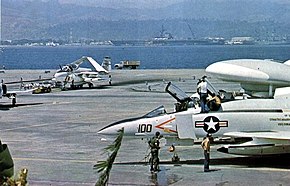
Sea Control Squadron 21 (VS-21) was an aviation unit of the United States Navy. It served from 1945 to 2005 and was mainly tasked with anti-submarine warfare while operating from aircraft carriers. It was the only squadron to receive the designations VA-1E, VC-21, or VS-21.

Fighter Squadron 213 (VF-213)

A carrier air wing is an operational naval aviation organization composed of several aircraft squadrons and detachments of various types of fixed-wing and rotary-wing aircraft. Organized, equipped and trained to conduct modern US Navy carrier air operations while embarked aboard aircraft carriers, the various squadrons in an air wing have different but complementary missions, and provide most of the striking power and electronic warfare capabilities of a carrier battle group (CVBG). While the CVBG term is still used by other nations, the CVBG in US parlance is now known as a carrier strike group (CSG).
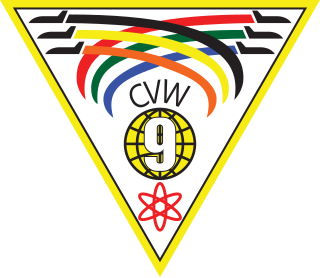
Carrier Air Wing Nine (CVW-9) is a United States Navy aircraft carrier air wing based at Naval Air Station Lemoore. The Air Wing is currently assigned to the aircraft carrier USS Abraham Lincoln (CVN-72). The Tail Code of aircraft assigned to CVW-9 is NG.
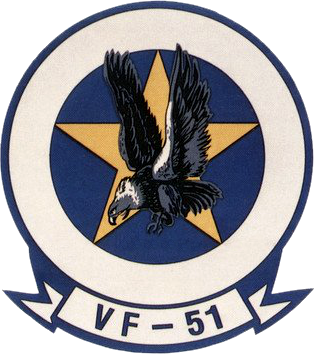
VF-51, Fighter Squadron 51 was an aviation unit of the United States Navy known as the "Screaming Eagles". It was originally established as VF-1 on 1 February 1943, redesignated as VF-5 on 15 July 1943, redesignated as VF-5A on 15 November 1946, redesignated VF-51 on 16 August 1948, and disestablished in March 1995. Until its disestablishment, VF-51 was the oldest fighter squadron in continuous service with the Pacific Fleet.

Strike Fighter Squadron 154 (VFA-154), also known as the "Black Knights", is a United States Navy strike fighter squadron stationed at Naval Air Station Lemoore. The Black Knights are an operational fleet squadron flying the F/A-18F Super Hornet. They are currently attached to Carrier Air Wing Eleven and deployed aboard the aircraft carrier USS Theodore Roosevelt. Their tailcode is NH and their callsign is "Knight".

Strike Fighter Squadron 97 (VFA-97) is a naval aviation squadron of the United States Navy. It is equipped with the F-35C Lightning II and is stationed at Naval Air Station Lemoore. The squadron is nicknamed "Warhawks" and it is currently assigned to Carrier Air Wing Two, tail code "NE". The squadron was originally established as Attack Squadron 97 (VA-97) on 1 June 1967 and redesignated VFA-97 on 24 January 1991.

Strike Fighter Squadron 94 (VFA-94), also known as the Mighty Shrikes, is a United States Navy fighter squadron stationed at Naval Air Station Lemoore. It is an operational fleet squadron currently flying the F/A-18E Super Hornet. It is attached to Carrier Air Wing 17 and based at NAS Lemoore, California. Its tail code is "NA" and its radio call sign is "Hobo".

Strike Fighter Squadron 195 (VFA-195), also known as the "Dambusters", is a United States Navy F/A-18E Super Hornet fighter squadron stationed at Marine Corps Air Station Iwakuni, Japan. They are a part of Carrier Air Wing Five (CVW-5) and their tail code is NF. Their radio callsign is "Chippy".

Strike Fighter Squadron 34 (VFA-34), also known as the "Blue Blasters", is a United States Navy F/A-18E Super Hornet strike fighter squadron stationed at Naval Air Station Oceana. They are a part of Carrier Air Wing 11 and are attached to the aircraft carrier USS Theodore Roosevelt. Their tail code is NH and their radio call sign is "Joker".
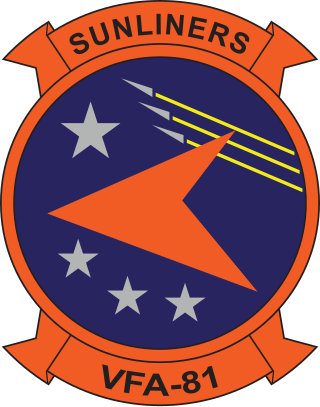
Strike Fighter Squadron 81 (VFA-81), also known as the "Sunliners", is a United States Navy F/A-18E Super Hornet strike fighter squadron stationed at Naval Air Station Oceana. They are currently assigned to Carrier Air Wing 1. Their mission is to conduct prompt and sustained combat operations from the sea. The squadron was originally designated VA-66 on 1 July 1955, was redesignated VF-81 the same day, redesignated VA-81 on 1 July 1959, and finally redesignated VFA-81 on 4 February 1988.
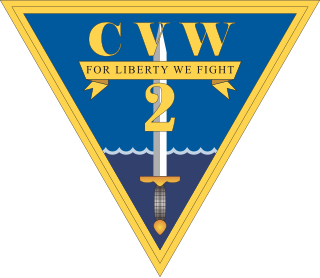
Carrier Air Wing Two (CVW-2) is a United States Navy aircraft carrier air wing based at Naval Air Station Lemoore. The air wing is attached to the aircraft carrier USS Carl Vinson (CVN-70).

Strike Fighter Squadron 192 (VFA-192), also known as the "World Famous Golden Dragons", are a United States Navy F/A-18E Super Hornet fighter squadron stationed at NAS Lemoore.

Carrier Air Wing Five (CVW-5) is a United States Navy aircraft carrier air wing based at Marine Corps Air Station Iwakuni. The air wing is attached to the aircraft carrier USS Ronald Reagan. It was initially formed in 1943. It has participated in the Second World War, the Korean War, the Gulf War, Operation Southern Watch, the War in Afghanistan, and the War in Iraq.

Carrier Air Wing Eleven (CVW-11) is a United States Navy aircraft carrier air wing based at Naval Air Station Lemoore, California. The air wing is attached to the aircraft carrier USS Theodore Roosevelt.

Carrier Air Wing Fourteen (CVW-14), was a United States Navy aircraft carrier air wing based at Naval Air Station Lemoore, California.

Carrier Air Wing Seventeen (CVW-17), is a United States Navy aircraft carrier air wing based at Naval Air Station Lemoore, California. The air wing is attached to the aircraft carrier USS Nimitz.
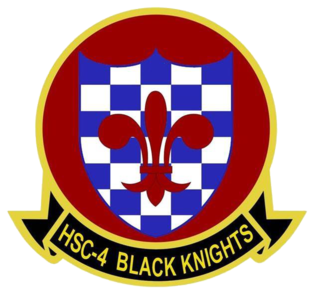
Helicopter Sea Combat Squadron Four (HSC-4), also known as the Black Knights, is a multi-role combat helicopter squadron of the United States Navy based at Naval Air Station North Island which operates Sikorsky MH-60S Seahawk helicopters deployed aboard aircraft carriers. The squadron was originally established as HS-4 on 30 June 1952 at U.S. Naval Auxiliary Landing Field Imperial Beach with the Sikorsky HO3S-1 and was redesignated HSC-4 on 29 March 2012. It is currently assigned to Carrier Air Wing Two (CVW-2) which deploys aboard USS Carl Vinson (CVN-70).

VA-52 was an Attack Squadron of the U.S. Navy. It was established as U.S. Navy Reserve Fighter Squadron VF-884 on 1 November 1949, and called to active duty on 20 July 1950. It was redesignated VF-144 on 4 February 1953, and VA-52 on 23 February 1959. The squadron was nicknamed the Bitter Birds from about 1951–1953, and the Knightriders from about 1960 onward. Its insignia evolved through several versions and variations from 1951 to the 1980s. VA-52 was decommissioned on 31 March 1995.

Carrier Air Wing Thirteen (CVW-13) was a carrier air wing of the United States Navy established for a short period at the end of the Cold War. There were three previous units which had been named Carrier Air Group Thirteen (CVG-13), dating as far back as 1942, though each of these units has a distinct lineage.

